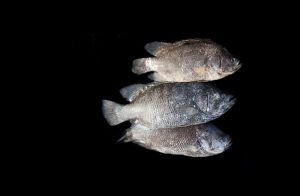Tripletail is a fish beloved in the sport fishing community and rather easy to catch by sight fishing, however not widely known outside of it. Having caught it for the first time, many angler ask themselves, can you eat tripletail fish?
The short answer is yes you can. We would actually encourage you very much to try it. Personally, I love the somewhat sweet taste of its white meat and have it rather often as part of the dinner menu.
Let’s look at the tripletail and its taste in more detail below!

Tripletail Facts
Tripletail fish like warmer waters, thus can be found mostly in tropical and subtropical ocean waters like Florida’s. Mostly, they are swimming close to the surface and rather close to the coast. Sometimes they are actually mistaken for trash or sargassum, which might be one of the reasons some consider them to be trash fish.
They have scales and three types of fins: dorsal, anal and cordal. The biggest triple tail caught weighed 42 pounds, though normally you will find them to be between 5 and 15 pounds.
In Florida and Georgie you can fish a maximum of two tripletail per day recreationally and they have to be at least 18 inch long.
How does Tripletail Taste?
Tripletail taste is often compared to grouper or snapper and it is actually really surprising that it is not better known. Its reputation as trash fish is certainly not warranted when it comes to taste!
Pan seared, it has both an intense and mild flavor. I would have to agree, as the “fishy” taste is not very pronounced, while a good fillet of tripletail steak certainly has its own distinct flavor, somewhat sweet (though not as sweet as Swedish Fish) and almost melting in your mouth.
Its firm but flaky texture is similar to barramundi or snapper and if you like white meat, you will definitely enjoy this as well. Whether prepared in the pan or the oven, you have to give it a try!
Can You Eat Tripletail Fish?
You certainly can eat triple tail fish! In fact, they are not considered to be endangered, making them a great target to go for, unlike for example blue marlin.
Are tripletail good to eat though?
Tripletail are a treat! Other than its taste, it also has a variety of beneficial nutrients. Omega 3 levels are not particularly low or high with about 0.6g per 100g, but it is a great source for it nevertheless!
I would recommend preparing it with just the basics, butter, salt, pepper, lemon and optionally garlic. This preserves and enhances its great flavor. As for side dishes, anything goes.
Tripletail Fish Price
Due to not being as common as other white fish, tripletail might be somewhat more difficult for you to find. Expect to pay about $25 per pound on the market for cut fillets, which is higher than e.g. snapper prices and comparably very high. The taste of the tripletail makes it still worth it though! Or alternatively, why not try to catch some yourself?
Is It Safe to Eat Tripletail?
In general, it is safe to eat tripletail. That is both for you, as well as the tripletail population. That being said, tissue mercury levels in tripletail are considered to be on the high side.
Therefore, go ahead and enjoy a plate of tripletail fish fillets with sides, but do so in moderation! It is probably advisable to not consume it more than once or twice per month.
Conclusion
We hope this article made you consider to try tripletail. Other than bowfin, triple tail really do not deserve their trash fish classification that some people assigned them to.
If you enjoy white fish meat from snapper or grouper, you will love tripletail fish. You might even end up discovering a new favorite for one of your baked or seared fish recipes.
Triple tail is also a quite sustainable fish to eat, as its population is not on the decline. If you do not catch it yourself, the fish might come imported from the gulf of Mexico, but that is still preferable to eating endangered species.
Finally, make sure to check out our related articles on blobfish, channel catfish, dogfish, flounder, pike, perch and tarpon!